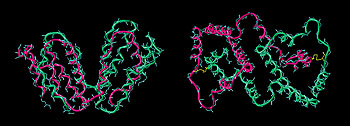Interferon-gamma (IFN-gamma) has multiple biological effects which have an influence on the human immune system. Based on these effects several therapeutic approaches were made. A major disadvantage for the therapeutic application of IFN-gamma is its low thermal stability and its tendency to form inactive aggregates.
Interferon-gamma variant with increased thermal stability

In contrast to most cytokines, the natural occuring human IFN-gamma does not possess disulfide bridges. Aim of this project is to introduce stabilizing disulfide bonds by means of genetic engineering without changing the overall structure of the protein.
Technology
Based on data of the known three-dimensional structure of IFN-gamma, insertion sites for disulfide bonds with very precise geometry were calculated using computer modelling techniques. Directed modification of the IFN-gamma gene was used to engineer these so called "third generation" variants.
Results
A total number of four different IFN-gamma variants was constructed, each containing two disulfide bonds. The new variant Interferon-gamma-HS was strongly stabilized in respect to thermal inactivation compared to wild type IFN-gamma and showed less tendency to aggregate. The biological activities were preserved.
This research project was honored by the International Society for Interferon and Cytokine Research (ISICR) by an research award in 1997.
Patents
A patent was filed for IFN-gamma-HS in Europe and Northern America.
 Fraunhofer Institute for Interfacial Engineering and Biotechnology IGB
Fraunhofer Institute for Interfacial Engineering and Biotechnology IGB